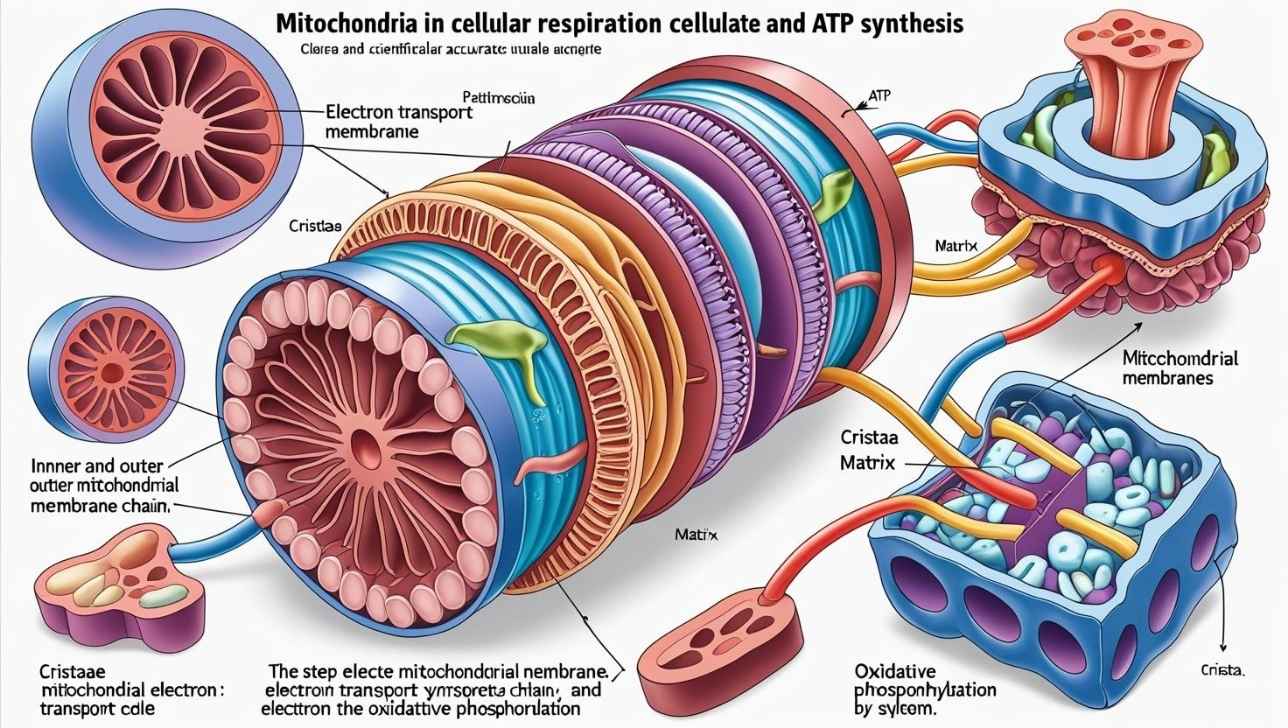Understanding the Role of Mitochondria in Energy Production
When you think about the powerhouse of the cell, mitochondria stand out as the key players in energy production. These tiny structures are found in almost every eukaryotic cell and play a crucial role in generating the energy needed for cellular functions. Understanding how mitochondria contribute to energy production can help us appreciate their importance in overall cellular health and metabolism.
Mitochondria are often referred to as the powerhouses of the cell because they generate most of the energy that cells need to function properly. This process is known as cellular respiration, which involves a series of biochemical pathways. The primary pathway responsible for energy production within mitochondria is called oxidative phosphorylation, where the energy stored in nutrients is converted into ATP (adenosine triphosphate), the energy currency of the cell.
The structure of mitochondria is uniquely suited to its function. Each mitochondrion has an outer membrane and an inner membrane, with the space between them called the intermembrane space. The inner membrane is highly folded, forming cristae, which increase the surface area and thus enhance the efficiency of energy production. Inside the inner membrane lies the matrix, where many of the enzymes involved in energy production are located.
To understand how mitochondria produce energy, let’s delve into the process of oxidative phosphorylation. This process consists of four main stages: glycolysis, the transition reaction, the citric acid cycle (also known as the Krebs cycle), and the electron transport chain. Here’s a breakdown of these stages:
- Glycolysis: Occurs in the cytoplasm and breaks down glucose into two molecules of pyruvate.
- Transition Reaction: Converts pyruvate into acetyl-CoA, which then enters the citric acid cycle.
- Citric Acid Cycle: Takes place in the mitochondrial matrix and generates high-energy molecules like NADH and FADH2.
- Electron Transport Chain: Located in the inner mitochondrial membrane, it uses electrons from NADH and FADH2 to pump protons across the membrane, creating a proton gradient. This gradient drives the synthesis of ATP through a process called chemiosmosis.
| Stage | Location | Key Molecules Produced |
|---|---|---|
| Glycolysis | Cytoplasm | Pyruvate |
| Transition Reaction | Cytosol | Acetyl-CoA |
| Citric Acid Cycle | Matrix | NADH, FADH2 |
| Electron Transport Chain | Inner Membrane | ATP |
The efficiency of energy production in mitochondria is remarkable. For each molecule of glucose, the complete process can yield up to 36-38 molecules of ATP. This makes mitochondria incredibly efficient at converting the energy stored in food into a form that cells can readily use.
Mitochondria also play a role beyond energy production. They are involved in other critical cellular processes such as calcium signaling, apoptosis (programmed cell death), and the production of reactive oxygen species (ROS). These additional roles highlight the multifaceted nature of mitochondria and their significance in maintaining cellular health.
Mitochondria are essential organelles that drive the energy production in cells through a series of intricate biochemical pathways. Their unique structure and function enable them to efficiently convert nutrients into ATP, supporting various cellular activities. Understanding the role of mitochondria in energy production not only provides insight into cellular metabolism but also underscores the importance of maintaining mitochondrial health for overall cellular and organismal well-being.
The Impact of Mitochondrial Dysfunction on Cellular Health
Mitochondria are often referred to as the powerhouses of the cell because they generate most of the cellular energy in the form of adenosine triphosphate (ATP) through a process called oxidative phosphorylation. However, their roles extend far beyond energy production. When mitochondria do not function correctly, it can lead to significant disruptions in cellular health. Understanding mitochondrial dysfunction and its impact is crucial for grasping the broader implications on overall health and disease.
Understanding Mitochondrial Function
Mitochondria are dynamic organelles with multiple functions including ATP production, calcium homeostasis, and apoptosis regulation. They contain their own DNA, known as mitochondrial DNA (mtDNA), which encodes for some essential proteins used in the electron transport chain. The rest of the proteins needed for mitochondrial function are encoded by nuclear DNA and imported into the mitochondria.
Energy Production and Cellular Health
The primary role of mitochondria is to produce ATP, which is the energy currency of the cell. ATP is generated through a series of reactions in the electron transport chain and the Krebs cycle. Disruption in these processes can lead to insufficient ATP production, causing cells to struggle with their basic functions. For instance, heart muscle cells, which require a constant supply of energy, are particularly vulnerable to mitochondrial dysfunction. This can result in conditions like cardiomyopathy where the heart muscle becomes enlarged and weak.
Calcium Homeostasis
Mitochondria play a key role in maintaining calcium levels within the cell. Calcium ions (Ca2+) are critical for various cellular processes, including muscle contraction, neurotransmitter release, and gene expression. When mitochondrial function is impaired, the ability to regulate intracellular calcium levels is compromised, leading to a buildup of calcium in the cytoplasm. This can trigger excessive activation of enzymes and pathways that may lead to cell damage or death.
Apoptosis Regulation
Mitochondria also regulate programmed cell death, or apoptosis, through the release of cytochrome c and other pro-apoptotic factors. Proper mitochondrial function ensures that cells undergo apoptosis when necessary, such as during development or in response to severe damage. Dysfunction in mitochondria can disrupt this process, leading to either too much cell death (which can harm tissues) or too little (which can promote cancer). For example, in neurodegenerative diseases like Alzheimer’s and Parkinson’s, mitochondrial dysfunction is linked to the accumulation of damaged neurons due to impaired apoptosis.
Implications of Mitochondrial Dysfunction
Mitochondrial dysfunction can arise from genetic mutations, environmental toxins, or simply aging. The consequences of such dysfunction are far-reaching and can affect multiple systems within the body. Here are some key areas impacted:
- Neurological Disorders: Conditions like Alzheimer’s and Parkinson’s disease are associated with mitochondrial dysfunction, leading to neuronal death and impaired brain function.
- Cardiovascular Diseases: Heart muscle cells require a lot of energy, making them susceptible to mitochondrial issues. This can lead to heart failure and other cardiovascular problems.
- Muscular Disorders: Mitochondrial myopathies are a group of neuromuscular diseases caused by damage to the mitochondria, leading to muscle weakness and fatigue.
- Metabolic Disorders: Mitochondrial dysfunction can interfere with metabolic pathways, leading to conditions such as diabetes and obesity.
- Aging: As we age, our mitochondria accumulate damage, leading to decreased energy production and increased susceptibility to disease.
Diagnosis and Treatment
Diagnosing mitochondrial dysfunction typically involves a combination of clinical assessment, blood tests, and genetic testing. Treatments are varied and depend on the underlying cause. Some common approaches include:
- Coenzyme Q10 Supplementation: CoQ10 is essential for the electron transport chain and can help mitigate some effects of mitochondrial dysfunction.
- Vitamin and Mineral Supplements: Vitamins B and C, along with minerals like magnesium, support mitochondrial function.
- Exercise and Diet: Regular physical activity and a balanced diet rich in antioxidants can help maintain mitochondrial health.
- Gene Therapy: For genetic disorders, gene therapy aims to correct faulty genes responsible for mitochondrial dysfunction.
Mitochondrial dysfunction has profound effects on cellular health, impacting energy production, calcium homeostasis, and apoptosis regulation. This dysfunction can lead to a wide range of diseases affecting the nervous system, muscles, heart, and metabolism. Understanding and addressing mitochondrial dysfunction is crucial for developing effective treatments and improving overall health outcomes.
Conclusion
Mitochondria play a crucial role in energy production, acting as the powerhouses of our cells by generating ATP through oxidative phosphorylation. Understanding their function helps us appreciate how vital they are for cellular health and overall bodily functions. However, when mitochondria malfunction, it can lead to a cascade of issues affecting cell health and contributing to various diseases. By recognizing the signs of mitochondrial dysfunction early, we can take steps to support their health through lifestyle changes and medical interventions. Investing in research and education about mitochondria ensures we can better manage and prevent conditions linked to their impairment, paving the way for improved health outcomes and quality of life.


